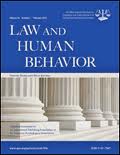
Ratings-based procedures can be used on children to mitigate problematic influences on child witnesses’ decision-making. This is the bottom line of a recently published article in Law and Human Behavior. Below is a summary of the research and findings as well as a translation of this research into practice.

Featured Article | Law and Human Behavior | 2017, Vol. 41, No. 6, 541-555
How Sure Are You That This Is The Man You Saw? Child Witnesses Can Use Confidence Judgements to Identify a Target
Author
Kaila C. Bruer, University of Regina
Ryan J. Fitzgerald, University of Portsmouth
Heather L. Price, Thompson Rivers University
James D. Sauer, University of Tasmania
Abstract
We tested whether an alternative lineup procedure designed to minimize problematic influences (e.g., metacognitive development) on decision criteria could be effectively used by children and improve child eyewitness identification performance relative to a standard identification task. Five hundred sixteen children (6- to 13-year-olds) watched a video of a target reading word lists and, the next day, made confidence ratings for each lineup member or standard categorical decisions for 8 lineup members presented sequentially. Two algorithms were applied to classify confidence ratings into categorical decisions and facilitate comparisons across conditions. The classification algorithms produced accuracy rates for the confidence rating procedure that were comparable to the categorical procedure. These findings demonstrate that children can use a ratings-based procedure to discriminate between previously seen and unseen faces. In turn, this invites more nuanced and empirical consideration of ratings-based identification evidence as a probabilistic index of guilt that may attenuate problematic social influences on child witnesses’ decision criteria.
Keywords
Child, eyewitness, confidence judgments, lineup identification
Summary of the Research
“Even in the most ideal situation eyewitness identifications can be inaccurate —this is especially true for child eyewitnesses who are more likely than adult eyewitnesses to identify an innocent person from a perpetrator-absent lineup. Given the fallibility of eyewitness memory, the approaches traditionally used to administer lineups to witnesses have been scrutinized. In response to this scrutiny, an alternative approach to improving accuracy with adult eyewitnesses was developed to mitigate factors that may influence witnesses’ decision criteria and increase error rates. The alternative approach permits eyewitnesses to provide a confidence judgment for each lineup member (reflecting their likelihood of guilt), rather than a traditional categorical decision. An algorithm that uses the distribution of confidence ratings can then be applied to derive identification and rejection classifications. This procedure has been effective at increasing accuracy for adult witnesses, particularly for perpetrator-absent lineups.” (p. 541)
“Child eyewitnesses, however, present a unique problem to the legal system. Research consistently demonstrates that child eye- witnesses are prone to choosing incorrectly from a lineup—especially the youngest children studied, those aged 5– 8 years. Because of their tendency to choose, children are particularly challenged when the perpetrator is absent from the lineup. Children’s problematic choosing may reflect the setting of overly lenient decision criteria (i.e., low threshold for selecting a lineup member) that results from peripheral factors, such as implicit social pressure to choose. However, research has yet to examine whether confidence ratings—a procedure that avoids single, explicit categorical decisions, potentially reducing the impact of nondiagnostic influences on criterion placement—can be used by children to effectively identify a target among foils in a lineup. We explored whether using confidence ratings could improve child eyewitness identification performance, relative to a standard identification task.” (p. 542)
“There is a long history of obtaining a confidence judgment as part of the eyewitness identification paradigm. Confidence judgments obtained immediately after the identification decision can be informative about likely accuracy, provided that the information has been processed under favorable conditions, a positive identification has been made, and no administrator feedback has been given. To be clear, an expression of high confidence in an identification decision is by no means conclusive evidence that the decision was accurate. Confident witnesses can be wrong. However, when aggregated across individuals, a relation between confidence and accuracy is typically found, particularly if calibration analyses are performed” (p. 542).
“Although a positive relation between confidence and accuracy has been demonstrated for adult witnesses, there is little evidence of a similar relation in children. Specifically, when children (10 to 13 years old) pick from a lineup, they show greater overconfidence and poorer calibration (cf. adults). However, in previous lineup research with children, the task involved a retrospective judgment of confidence about a categorical identification. Findings in the developmental metacognitive literature suggest children may nevertheless be able to use confidence as an index of memory, thus suggesting the lineup literature has just not yet found how to make such a procedure work for child witnesses.” (p. 543)
“A confidence rating procedure also changes the lineup task from a single decision involving numerous stimuli to a series of responses, each to a single stimulus, which may be particularly advantageous for children. Making a categorical lineup identification requires complex processing (i.e., assessing which one face matches their memory of the target better than other faces) that induces a large cognitive load and, in turn, may negatively impact performance. Circumventing the need for a child to make a categorical identification could reduce the cognitive load associated with the task, alleviate inherent pressure to choose that is associated with making a single, categorical, and mitigate problems associated with use of overly lenient decision criteria. Thus, children may be able to use confidence ratings to discriminate previously seen from unseen faces.” (p. 543)
“Children (aged 6–8 and 9–13 years) viewed a video of a target and then completed a categorical or confidence lineup procedure on the following day. For the confidence procedure, confidence ratings were collected for each lineup member and then classified as positive (those who made an identification) or negative (those who rejected the lineup) decisions. These classifications were then compared to responses from children who made categorical lineup decisions. Both the confidence and categorical procedure presented the lineup members sequentially” (p. 543).
“[W]e assessed whether or not children could use the confidence rating procedure to accurately discriminate between previously seen and unseen faces. This research provides early evidence that confidence ratings can provide meaningful information about children’s recognition memory. This conclusion is based on three analyses. First, [adjusted normalized discrimination index; ANDI] scores demonstrated that both younger and older children were able to use confidence ratings to discriminate between previously seen and unseen faces. Second, the algorithms were able to classify children’s responses such that suspect identification accuracy was above chance (50%). Third, the observed linear pattern between discrepancy and classification accuracy rates in the profile analysis demonstrates that children’s confidence ratings can be used to effectively discriminate guilty from innocent suspects. These data demonstrate that both age groups of children can use confidence ratings to index likely guilt in a way that reduces or mitigates decision criteria influences, and permits a probabilistic assessment of identification evidence. This crucial finding provides the foundation for further exploration of procedures based on children’s confidence assessments.” (p. 551)
Translating Research into Practice
“[T]his research is currently most informative from a cognitive perspective, as it is premature to apply the confidence procedure to legal settings. However, there is value in considering the impact this sort of procedure may have on the legal system. For example, how will legal decision makers consider evidence based on confidence ratings, rather than a clear, categorical decision? As indicated by previous research, hearing an eyewitness state “that’s the guy I saw” is a powerful and persuasive form of evidence. Not providing that information to decision makers in a legal setting may prove to be a challenge to those expecting finality in a witness statement. However, when considering the purpose of conducting a lineup task, there is a clear space for use of a confidence procedure in the legal system. And, although less traditional, Sauer, Palmer, and Brewer recently reported that mock jurors are receptive to noncategorical forms of identification evidence and, with coaching, can appropriately evaluate this type of evidence. As Charman and Wells point out, the aim of a police lineup is not to test the eyewitness but, rather, to gather evidence as to the guilt of a possible suspect. From this perspective, the confidence procedure may provide more valuable eyewitness evidence than the current lineup paradigms available to investigators.” (p. 551-552)
“Confidence rating-based identification evidence has several advantages over a categorical identification. For instance, confidence ratings for each lineup member provide investigators with multiple points of information, including which member best matches a child’s memory of a perpetrator as well as the degree to which the best match is preferred, relative to the other members. Importantly, although collapsing patterns of confidence ratings into categorical classifications is useful for comparing performance against a traditional lineup procedure, this actually obscures some of this useful information. Recognition memory is not an “all or nothing” construct; the strength of recognition falls on a continuum. Thus, we argue that there is merit in encouraging legal decision makers to shift from interpreting identification evidence as a clear-cut indication of guilt toward a more probabilistic treatment of the evidence. Moving from a categorical treatment of identification evidence to a ratings-based approach recognizes this distinction. The ratings-based approach allows for graded evidence against a suspect based on both the strength of the witness’s recognition of the suspect and the witness’s ability to discriminate between the suspect and other lineup members. The potential value of this approach is evident in the linear relationship observed in the profile analysis reported […]. As the level of discrepancy increases, so too does the likely guilt of the suspect. Thus, the most important aspect of the current findings may not be the actual accuracy rates observed, but the evidence that even younger children can use confidence ratings to discriminate guilty from innocent suspects.” (p. 552)
Other Interesting Tidbits for Researchers and Clinicians
“[…] many children provided multiple maximum ratings. In keeping with previous research, responses from those who provided multiple max ratings were classified as rejections. However, there are nuances in these multiple maximum responses that may provide valuable information about memory strength. For example, does providing a maximum rating to four faces indicate a weaker memory than providing a maximum rating to only two faces? How informative is a child’s memory when he or she provides a maximum rating to the suspect, along with one other lineup member (vs. two or three others)? There is a need to further explore the value of the confidence procedure as probabilistic evidence of suspect guilt, including whether the number of maximum ratings provided (and who they are given to) can be used as a supplemental index of recognition memory.” (p. 552)
“[…] given that this was an initial exploration of children’s use of confidence ratings and we did not focus on exploring developmental differences, we did not have a sample size large enough to capture the nuanced differences that can be expected for children aged 6–7, from those who are 8–9, and beyond. Therefore, the lack of observable differences between age groups may be due to exploring age categorically, rather than continuously. Going forward, it would be beneficial to focus on a narrower age range of children or explore age continuously in order to learn more about developmental differences in use of confidence ratings.” (p. 552)
Join the Discussion
As always, please join the discussion below if you have thoughts or comments to add! To read the full article, click here.






















